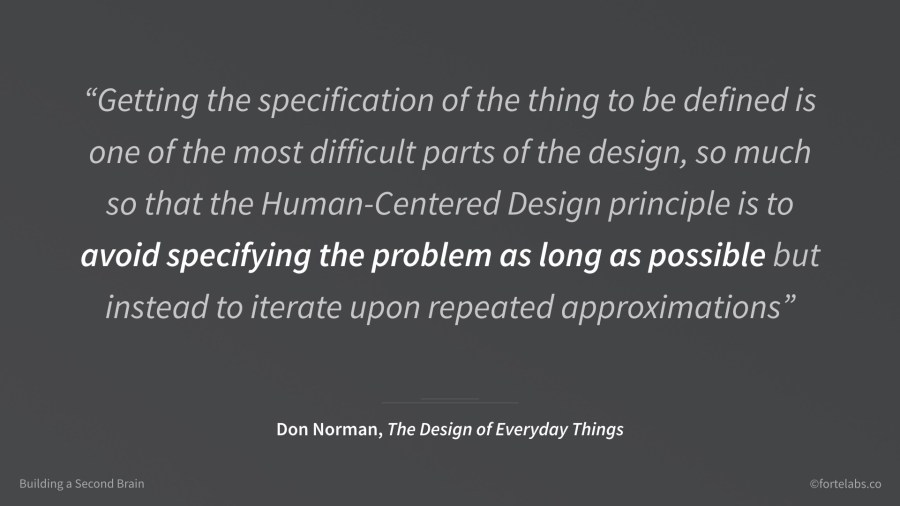
In Part 9, I explained why it is so important to create placeholders for your work-in-process: to allow you to pursue multiple projects across different spans of time without losing your progress.
What we are converging towards is a set of core principles for how Digital Knowledge Work is fundamentally different from previous kinds of work.
Knowledge work by itself isn’t new. Humans have been working with information for centuries in different forms. But the rise of digital information technology has ushered in a revolution in how work can be executed. And with it, a revolution in how work should be executed.
We are moving from a Just-In-Case to a Just-In-Time paradigm.
Under the JIC paradigm, we are encouraged to perform a whole range of activities in advance, to plan and prepare for a future we are assured will surely come.
So we get good grades “just in case.” We get a prestigious degree “just in case.” We get a good job “just in case.” We carefully plan our projects “just in case.” We do everything conservatively and way in advance, not taking any risks “just in case” something bad were to happen.
In case it isn’t already obvious, it no longer works to live life just in case. You can follow all the rules, check all the boxes, and still not succeed, on the scale of the smallest project all the way up to your whole life plan.
The key tenet of the Just-In-Time paradigm is that the best possible time to do most tasks is “as late as possible.”
To most people this sounds an awful lot like procrastinating. It runs against everything we’ve been taught about responsibility, diligence, and reducing risk.
Let’s dive deep into the essential nature of digital knowledge work to discover why just-in-time action makes so much sense.
#1 Structure can be added later
The first principle of digital knowledge work is that structure can be added later.
This isn’t true for physical work. You can’t erect an office building and then later decide you’d like it to be a stadium or airport instead.
But in frictionless digital environments, this restructuring becomes not only possible; it is the best possible way to do things.
You can dump project files into a folder, only later dividing them into subfolders when you need them. You can collect photos and screenshots from around the web, only later pulling them into a webpage. You can save random snippets of text with ideas and quotes, waiting until later to rearrange them into a coherent document.
Defining a structure too early in the process not only consumes your time and attention, it presents real risks. It can blind you to ideas that don’t fit the structure. It can create unnecessary hierarchy and complexity before it’s needed. It can keep you from getting started because it seems to require a lot of dedicated effort.
It makes much more sense to just start collecting things – ideas, theories, possibilities, options, features, questions – and only later choose the appropriate structure based on the patterns that emerge from the material.
#2 Features can be added later
Not only can structure be added after the fact, so can features.
This is another unique characteristic of digital knowledge work. You can’t add features to a stove after it’s been sold and installed in a kitchen. You can’t update a book with the latest research once it’s printed.
But with digital, you can. And once again, it becomes the best possible way to create new things.
You can launch a basic website, and add new pages and content over time. You can release a beta software program, adding functionality with each software update. Even for something as simple as a Word document, all that’s required is putting a v2 in the title, and you’ve created an update.
Adding too many features too early also presents serious risks. You might spend a lot of time on them, only to realize your customers value different features. You might dilute your focus, launching 10 mediocre features instead of one or two really great ones. You might confuse your audience, muddling your intentions with too many bells and whistles.
It makes much more sense to launch a container, and fill in the features slowly over time via releases – discrete packets of incremental value delivered to users. Most knowledge work is nothing but files on computers or servers, which means it’s all mutable.
This is called “versioning,” and represents one of the most powerful forms of downscoping available to us as digital knowledge workers. For any task, deliverable, product, or project we’re having trouble finishing, we can simply postpone features to future releases until it becomes small enough to manage.
This way of delivering your work becomes not only possible but preferable. It conserves resources, gives you precious learning sooner, and reduces the risk that you’ll deliver the wrong thing.
#3 Purpose can be added later
Not only can structure and features be added after the fact, but even the purpose of the product you’re creating.
You can write an email to a colleague explaining how to use an internal software program, and suddenly realize it could easily be turned into a wiki for future employee reference. You can produce a schedule for an individual project, only to realize that it can become a template for future ones. You could start collecting travel ideas for your own trip, only to realize you could publish a blog post and make that knowledge available to others.
Settling on a purpose too early imposes perhaps the most serious risks on a project. A purpose powerfully constrains what is allowed and what is possible. In a world of endless possibilities and potential new avenues, such constraints can be devastating. You might miss an enormous opportunity in your blind spot, because you don’t think to question the ultimate purpose of what you’re doing.
It’s better to leave the purpose, goals, outcomes, or the problem to be solved for a project ill-defined, allowing them to emerge slowly as you make discoveries. Or you can set them precisely, but remain open to radical revisions as you test your assumptions.
Flexibility in outcomes is one of the most powerful features of digital knowledge work. It allows us to adapt quickly to anything that happens, dropping or adding structures and features as needed to pursue whichever purpose we are currently aiming for.
Follow us for updates on Twitter, Facebook, Instagram, LinkedIn, or YouTube.
The Only Subscription
You Need to
Stay at the
Edge of AI
The essential toolkit for those shaping the future
"This might be the best value you
can get from an AI subscription."
- Jay S.
Join 100,000+ leaders, builders, and innovators

Email address
Already have an account? Sign in
What is included in a subscription?
Daily insights from AI pioneers + early access to powerful AI tools








Comments
Don't have an account? Sign up!